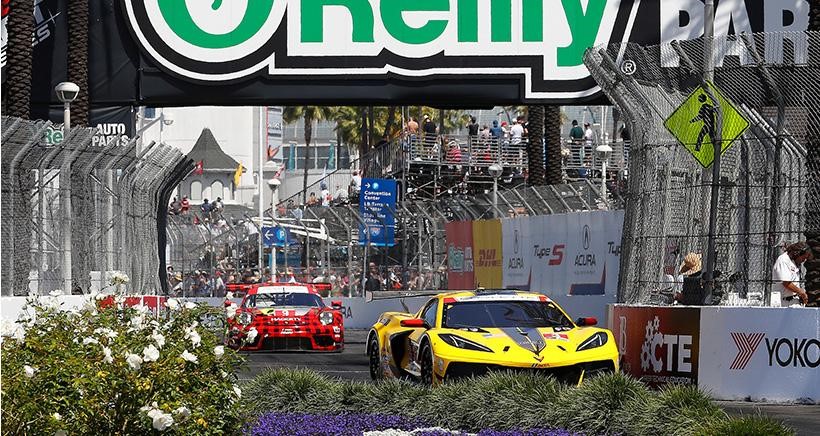The IMSA WeatherTech SportsCar Championship pays a quick visit to Southern California this weekend for the Acura Grand Prix of Long Beach. Quick? With practice, qualifying and the race all shoehorned into Friday and Saturday, it’s the shortest race weekend of the 2023 season. Quick? At 100 minutes from green flag to checkered, Long Beach is the shortest race on the series’ calendar.
The Heat Is On … and Off
Given that track time is at a premium, the proverbial heat will be on the Grand Touring Prototype (GTP) and Grand Touring Daytona (GTD) and GTD PRO teams and drivers to hit the ground running on Friday for the two practice sessions leading up to qualifying. Then again, with qualifying slated for 5:15 p.m. PT Friday, race engineers, mechanics and drivers will have to translate the knowledge and data on car setups, braking points, tire pressures and the like gleaned from practice earlier in the day into qualifying runs in the cooler temps of late afternoon. And with overtaking always difficult on the Jersey barrier-lined city streets and little more than an hour and a half in which to gain track position during the race, a good qualifying performance is critical to a team’s chances of a strong finish.
The Heat Is On to Stay
Jersey barrier-lined city streets? Like any street circuit, the 11-turn, 1.968-mile Long Beach track takes no prisoners. There is no such thing as a minor “off.” Stray six inches off line at Daytona International Speedway’s International Horseshoe or Sebring International Raceway’s Tower Turn and, odds are, you’ll lose time, spin or, at worst, damage your car’s underbody. Make the same mistake at Long Beach and your race will almost certainly be over in an instant and your car will return to the paddock on the business end of a wrecker.
A similar error in practice or qualifying will likely result in a long Friday night and/or an early Saturday morning for your mechanics or, worse, relegation to the ranks of spectator come Saturday afternoon’s race. Thus, from the moment the green flag waves on Friday’s first practice session until the checkered flag flutters at the finish of Saturday’s 100-minute race, the heat is on drivers to “keep it between the walls.”
The Heat Is On the Pit Crews
With just a single pit stop scheduled for each of the GTP, GTD PRO and GTD cars during those 100 minutes, the heat is on the pit crews to perform flawlessly. Cross-thread a lug nut, drop the air jack a moment too soon (or late), short fill the fuel tank … the slightest hitch in a car’s “routine” servicing can leave the driver taking over the wheel with a mountain to climb in order to regain lost positions.
And speaking of drivers, it behooves the drivers entering the pits to hit their marks such that the crews can comfortably perform their various tasks. Similarly, the driver exchange has to be performed with a precision and, dare we say, elegance worthy of the Bolshoi Ballet. What’s more, the individual assigned to “release” the car from the pit stall has to do so in a manner that avoids other cars entering or exiting their own pits. And finally, as slow as the car seems to be trundling down pit lane, the driver must be careful not to exceed the speed limit exiting the pits lest he or she be assessed a penalty that will almost certainly nix any chances of a good finish.
While there is no substitute for a car’s outright speed at Long Beach, a team’s chances of success also come down to execution by drivers, race engineers, mechanics and pit crew – not to mention the strategists who decide when to make that crucial pit stop. All told, that’s a lot to pack into the last 100 minutes of a two-day race weekend.
- IMSA Long Beach results: Single-set tire run propels No. 01 Cadillac ; Lexus takes GTD - April 20, 2024
- Full IMSA results from Road Atlanta as No. 31 Cadillac Takes GTP Title, No. 60 Acura Win Race - October 15, 2023
- IMSA results from Indy: Porsche Penske 1-2 Sweep, TDS Racing takes LMP2, Mercedes scores third GTD PRO win - September 17, 2023
